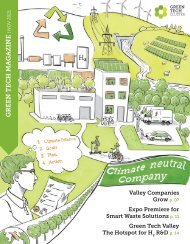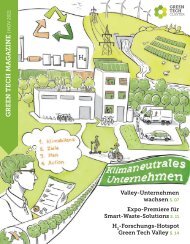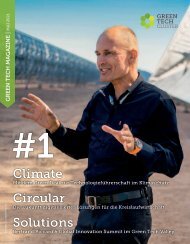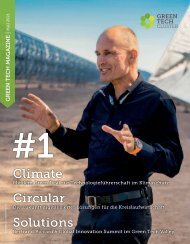Green Tech Magazine May 2019 en
Green Urban Life Urban spaces around the world are trialling advanced technologies and sustainable concepts. These cities of the future are all about a green lifestyle. The Smart City of Graz is taking a new approach to urban development at the interface between energy, mobility and lifestyle with everything from regional energy production and storage, innovative building technologies and rooftop farming. Water is the source of all life and Styrian companies are bubbling over with innovation and expertise on resource conservation, water treatment, irrigation systems, hydropower and the cooling of public spaces. Styria is a hotspot for young green talent, as the creative ideas that emerged from the interdisciplinary student Green Tech Jam hackathon prove. And the JOANNEUM RESEARCH lifestyle check shows what each and every one of us needs to do to have a sustainable lifestyle.
Green Urban Life
Urban spaces around the world are trialling advanced technologies and sustainable concepts. These cities of the future are all about a green lifestyle. The Smart City of Graz is taking a new approach to urban development at the interface between energy, mobility and lifestyle with everything from regional energy production and storage, innovative building technologies and rooftop farming.
Water is the source of all life and Styrian companies are bubbling over with innovation and expertise on resource conservation, water treatment, irrigation systems, hydropower and the cooling of public spaces.
Styria is a hotspot for young green talent, as the creative ideas that emerged from the interdisciplinary student Green Tech Jam hackathon prove. And the JOANNEUM RESEARCH lifestyle check shows what each and every one of us needs to do to have a sustainable lifestyle.
Create successful ePaper yourself
Turn your PDF publications into a flip-book with our unique Google optimized e-Paper software.
carbon pricing initiatives
Carbon price
(US$/tCO 2 e)
2 CONTENTS
US$ 150/
tCO 2 e
US$ 125/
tCO 2 e
Sweden
carbon tax
Share of emissions covered and carbon
pricing revenues of implemented
carbon pricing initiatives
DEAR READERS,
across the world, urban spaces
are trialling innovative projects
establishing the sustainable cities
of the future. Graz is developing
a new district, Smart City, to promote
green energy, healthy mobility
and intelligent planning, with
everything from regional energy
production and storage to innovative
building technologies through
to urban farming.
Water is the source of all life and
the Wasserland Steiermark companies
are bubbling over with innovation
and expertise on resource
conservation, water treatment, irrigation
systems, hydropower and
the cooling of public spaces.
Styria is a hotspot for young green
talent, as the creative ideas that
emerged from the interdisciplinary
student Green Tech Jam hackathon
prove. And the JOANNEUM
RESEARCH lifestyle check shows
what each and every one of us
needs to do to have a sustainable
lifestyle. How green is your lifestyle?
We hope you will enjoy reading
and being inspired by the articles
that follow.
Bernhard Puttinger
and the Green Tech Cluster Styria
Team
04
Green Talent
Winners of the Green Tech Jam
push electricity at “High Noon”
Page 07
Lifestyle check
How green is
your lifestyle?
Page 12
Partners: Österreichisches Umweltzeichen, eco label, PEFC, FSC
08
Smart City
Sustainable energy
and mobility in Graz
Page 04
Fresh Green Tech
Styrian solid-state battery
wins coveted award
Page 08
Publication details: Media owner and publisher: Green Tech Cluster Styria GmbH, Waagner-Biro-Straße 100, 8020 Graz, Austria, Tel.:
+43 316 40 77 44-0, welcome@greentech.at, www.greentech.at. Content and project management: Andreas
Pompenig, Bernhard Puttinger | Production: Die Steirerin Verlags GmbH & Co KG, Schubertstraße 29/1, 8010 Graz,
Tel.: +43 316 84 12 12-0, www.diesteirerin.at | Print: Schmidbauer GmbH, www.derschmidbauer.at
07
14
12
Latest
highlights
Land of water
Where innovation
bubbles up
Page 14
Did youknow?
The next
boating revolution
Page 16
16
Photo credits: Green Tech Cluster, Bernhard Bergmann, Bauer Group, Atelier für Architektur, Cameron Venti, Tom Trenkle
Photo credits: EPS/Pushkar, Denise Hastert @ Wikimedia Commons – CC BY-SA 4.0, www.worldbank.org, Shutterstock, Graphic: provided
World News
Carbon dioxide taxes on the rise
88 participants, they are responsible for 56 % of all greenhouse gas
emissions worldwide, agreed at the Paris Climate Conference on
climate protection targets. Compulsory carbon dioxide taxes were
one of the key instruments agreed. According to a report by the
World Bank, 51 international, national and regional environmental
programmes have so far included carbon dioxide taxes. These cover
eleven gigatonnes of CO 2
, or around 20 % of greenhouse gases globally.
Carbon dioxide taxes brought in 82 billion USD in 2018 and 52
billion USD in 2017. Sweden is at the forefront with over 130 USD per
tonne of CO 2
, followed by Liechtenstein and Switzerland, each with
around 100 USD/t and Finland with 75 USD/t. www.worldbank.org
Global energy production growth 2018 (selected regions)
in MTOE (Million Tonnes of Oil Equivalent)
Free transport for all in Luxembourg
Luxembourg is forging ahead with a far‐reaching switch to public
transport. From March 2020, not only city residents but also all tourists
will be able to use public transport free of charge. Anyone wanting to
travel within the EU’s second smallest state by bus, tram or train will
only need to show their ID or passport instead of a ticket. The initiative
is being financed by EUR 41 million from tax revenues. Luxembourg
isn't the only country in Europe introducing this kind of measure. The
Estonian capital of Tallinn is also pioneering free public transport.
People registered in the city have been able to use trams, buses and
trains free of charge since 2013, and 8 % more people now travel by
bus and train in Tallinn. www.luxembourg.public.lu
US$ 100/
tCO 2 e
US$ 75/
tCO 2 e
US$ 50/
tCO 2 e
US$ 25/
tCO 2 e
US$ 0/
tCO 2 e
Spain
carbon tax
Liechtenstein
carbon tax
UK carbon
price floor
Iceland
carbon tax
France
carbon tax
Switzerland Latvia
ETS carbon Slovenia
tax carbon tax
Estonia
Chile
carbon
carbon
tax
Colombia
tax
carbon tax
Portugal
Poland carbon tax
carbon tax
RGGI
Switzerland
carbon tax
Finland
carbon tax
Denmark
carbon tax
Alberta carbon tax
EU ETS
Alberta CCIR
Ireland carbon tax
Norway
carbon tax
Mexico
carbon
tax
Shanghai
pilot ETS
Guangdong
pilot ETS
0% 10% 20% 30% 40% 50% 60% 70% 80% 90% 100%
Share of GHG emissions covered in the jurisdiction
Note: The size of the circles is proportional to the amount of government revenues except for initiatives with government revenues below US$100 million in 2017;
the circles of these initiatives have an equal size. For illustrative purposes only, the nominal prices on April 1, 2018 and the coverages in 2018 are shown. The carbon
tax rate applied in Mexico and Norway varies with the fossil fuel type and use. The carbon tax rate applied in Denmark varies with the GHG type. The graph shows the
average carbon tax rate weighted by the amount of emissions covered at the different tax rates in those jurisdictions. The middle point of each circle corresponds to
the price and coverage of that initiative.
Renewables are growing
The latest statistics from the International Energy Agency (IEA) on
energy and CO 2
developments present a mixed picture. Global energy
consumption rose in 2018 by 2.3 %, almost twice the yearly average
since 2010. CO 2
emissions grew by 1.7 % worldwide, whilst decreasing
by 1.3 % in Europe. The relative growth in renewables by 4 % compared
with the previous year, meeting 15 % of global energy needs,
is encouraging. China and Europe played a leading role here, with
solar PV, hydropower, wind energy and biomass all seeing growth.
Renewables represent a quarter of all growth, or 45 % of electricity
generation growth for 2018. www.iea.org/geco/
Sunny Outlook for India
California CaT
Ukraine carbon tax
India now has around 1.3 billion inhabitants – and its electricity demand
is growing rapidly. To keep down CO 2
emissions, the Indian government
wants to raise production of renewable energy to 175 gigawatts by
2022. This corresponds to a share of 50 percent of the total “energy
pie”. Advantage: The production of solar power is significantly more
lucrative in India than in Northern Europe, for example – the sun has
more power and shines more constantly. As in the southern Indian
state of Karnataka, where a 700,000 square metre solar energy plant
has been operational since the beginning of 2018, supplying 72,000
people in the region with clean solar energy. It is also planned to use
wind, biomass and hydropower as sources of renewable energy over
the next three years. www.dw.com
Japan
carbon
tax
BC carbon tax
Ontario
CaT
Québec CaT

















